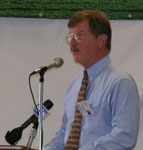 USDA’s Natural Resources Conservation Service is on the forefront of developing plants that could be used as future energy sources through the NRCS Plant Materials Program. National Program leader for Plant Materials Bob Escheman says that is part of their mission to solve resource concerns.
USDA’s Natural Resources Conservation Service is on the forefront of developing plants that could be used as future energy sources through the NRCS Plant Materials Program. National Program leader for Plant Materials Bob Escheman says that is part of their mission to solve resource concerns.
 “The Plant Material program began back in the middle ‘30s when the Soil Conservation Service was established,” Escheman said. “We are now getting into bioenergy where we are working with universities and other producers.”
“The Plant Material program began back in the middle ‘30s when the Soil Conservation Service was established,” Escheman said. “We are now getting into bioenergy where we are working with universities and other producers.”
One of the plants they are working on developing for energy is switchgrass, which became famous when President Bush mentioned it last year in his State of the Union address.
“We’ve been growing switchgrass since the 1950s and we are trying to find where we can best grow the plant for bioenergy uses,” said Escheman.
One of the main problems of using switchgrass as a biofuel has been the amount of ash which is created after burning it. To solve this problem, the Plant Materials Centers (PMC) at Knox City, Texas and Elsberry, Missouri, along with the USDA Agricultural Research Service and Mississippi State University are cooperating on a study to investigate how the timing of harvesting affects biomass yield and the biofuel-quality of switchgrass.
 There are 27 regional NRCS Plant Materials centers nationwide, including one in Brooksville, Florida. State Conservationist Niles Glasgow, who is also chairman of the National Plant Materials Advisory Committee, says bioenergy research is an exciting area for the program.
There are 27 regional NRCS Plant Materials centers nationwide, including one in Brooksville, Florida. State Conservationist Niles Glasgow, who is also chairman of the National Plant Materials Advisory Committee, says bioenergy research is an exciting area for the program.
“One of the big things we have to start looking at is what kind of plants are going to produce the most amount of mass that can be turned into fuel,” said Glasgow.
He notes that Florida Agriculture Commissioner Charles Bronson is very interested in making the Sunshine State a major player in alternative fuels. “And we know that will not be from growing corn, it will be from growing grass” or different types of sugarcane.
Both Escheman and Glasgow believe that the role of the Plant Materials Program in developing sources for alternative fuels is just beginning.

